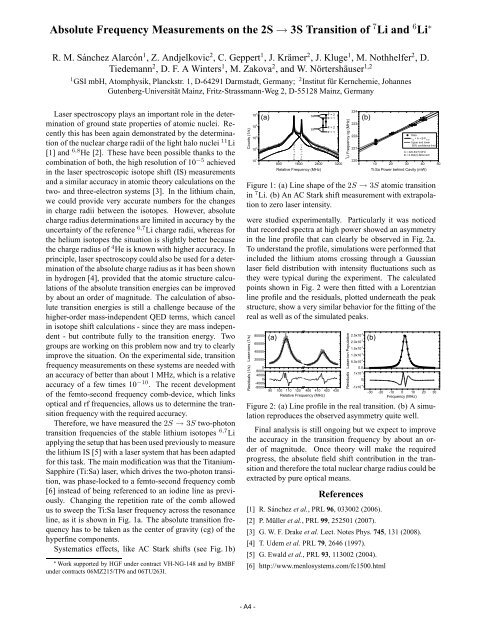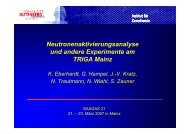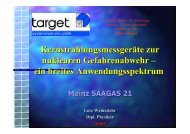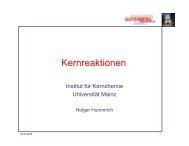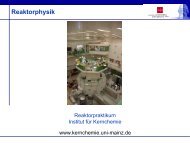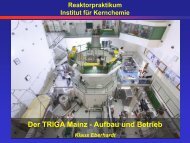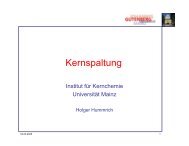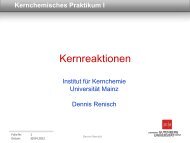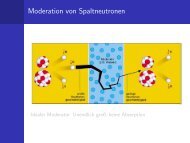jahresbericht 2007 - Institut für Kernchemie - Johannes Gutenberg ...
jahresbericht 2007 - Institut für Kernchemie - Johannes Gutenberg ...
jahresbericht 2007 - Institut für Kernchemie - Johannes Gutenberg ...
You also want an ePaper? Increase the reach of your titles
YUMPU automatically turns print PDFs into web optimized ePapers that Google loves.
Absolute Frequency Measurements on the 2S → 3S Transition of 7 Li and 6 Li ∗<br />
R. M. Sánchez Alarcón 1 , Z. Andjelkovic 2 , C. Geppert 1 , J. Krämer 2 , J. Kluge 1 , M. Nothhelfer 2 , D.<br />
Tiedemann 2 , D. F. A Winters 1 , M. Zakova 2 , and W. Nörtershäuser 1,2<br />
1 GSI mbH, Atomphysik, Planckstr. 1, D-64291 Darmstadt, Germany; 2 <strong>Institut</strong> für <strong>Kernchemie</strong>, <strong>Johannes</strong><br />
<strong>Gutenberg</strong>-Universität Mainz, Fritz-Strassmann-Weg 2, D-55128 Mainz, Germany<br />
Laser spectroscopy plays an important role in the determination<br />
of ground state properties of atomic nuclei. Recently<br />
this has been again demonstrated by the determination<br />
of the nuclear charge radii of the light halo nuclei 11 Li<br />
[1] and 6,8 He [2]. These have been possible thanks to the<br />
combination of both, the high resolution of 10 −5 achieved<br />
in the laser spectroscopic isotope shift (IS) measurements<br />
and a similar accuracy in atomic theory calculations on the<br />
two- and three-electron systems [3]. In the lithium chain,<br />
we could provide very accurate numbers for the changes<br />
in charge radii between the isotopes. However, absolute<br />
charge radius determinations are limited in accuracy by the<br />
uncertainty of the reference 6,7 Li charge radii, whereas for<br />
the helium isotopes the situation is slightly better because<br />
the charge radius of 4 He is known with higher accuracy. In<br />
principle, laser spectroscopy could also be used for a determination<br />
of the absolute charge radius as it has been shown<br />
in hydrogen [4], provided that the atomic structure calculations<br />
of the absolute transition energies can be improved<br />
by about an order of magnitude. The calculation of absolute<br />
transition energies is still a challenge because of the<br />
higher-order mass-independent QED terms, which cancel<br />
in isotope shift calculations - since they are mass independent<br />
- but contribute fully to the transition energy. Two<br />
groups are working on this problem now and try to clearly<br />
improve the situation. On the experimental side, transition<br />
frequency measurements on these systems are needed with<br />
an accuracy of better than about 1 MHz, which is a relative<br />
accuracy of a few times 10 −10 . The recent development<br />
of the femto-second frequency comb-device, which links<br />
optical and rf frequencies, allows us to determine the transition<br />
frequency with the required accuracy.<br />
Therefore, we have measured the 2S → 3S two-photon<br />
transition frequencies of the stable lithium isotopes 6,7 Li<br />
applying the setup that has been used previously to measure<br />
the lithium IS [5] with a laser system that has been adapted<br />
for this task. The main modification was that the Titanium-<br />
Sapphire (Ti:Sa) laser, which drives the two-photon transition,<br />
was phase-locked to a femto-second frequency comb<br />
[6] instead of being referenced to an iodine line as previously.<br />
Changing the repetition rate of the comb allowed<br />
us to sweep the Ti:Sa laser frequency across the resonance<br />
line, as it is shown in Fig. 1a. The absolute transition frequency<br />
has to be taken as the center of gravity (cg) of the<br />
hyperfine components.<br />
Systematics effects, like AC Stark shifts (see Fig. 1b)<br />
∗ Work supported by HGF under contract VH-NG-148 and by BMBF<br />
under contracts 06MZ215/TP6 and 06TU263I.<br />
Counts (1/s)<br />
10 5 3s F = 2<br />
F = 1<br />
10 4<br />
10 3<br />
10 2<br />
(a)<br />
F = 2 F = 2<br />
F = 1 F = 1<br />
F = 2<br />
F = 1<br />
10 1<br />
0 800 1600 2400 3200<br />
Relative Frequency (MHz)<br />
2s<br />
7 Li Frequency cg (MHz)<br />
224<br />
223<br />
(b)<br />
222<br />
Data<br />
= A + B·P cg Ti:Sa<br />
Upper and lower<br />
95% confidence limit<br />
221<br />
A = 220.84(7) MHz<br />
B = 0.062(3) MHz/mW<br />
220<br />
0 10 20 30 40 50<br />
Ti:Sa Power behind Cavity (mW)<br />
Figure 1: (a) Line shape of the 2S → 3S atomic transition<br />
in 7 Li. (b) An AC Stark shift measurement with extrapolation<br />
to zero laser intensity.<br />
were studied experimentally. Particularly it was noticed<br />
that recorded spectra at high power showed an asymmetry<br />
in the line profile that can clearly be observed in Fig. 2a.<br />
To understand the profile, simulations were performed that<br />
included the lithium atoms crossing through a Gaussian<br />
laser field distribution with intensity fluctuations such as<br />
they were typical during the experiment. The calculated<br />
points shown in Fig. 2 were then fitted with a Lorentzian<br />
line profile and the residuals, plotted underneath the peak<br />
structure, show a very similar behavior for the fitting of the<br />
real as well as of the simulated peaks.<br />
Laser-ions (1/s)<br />
Residuals (1/s)<br />
80000<br />
60000<br />
40000<br />
20000<br />
(a)<br />
0<br />
8000<br />
4000<br />
-4000 0<br />
-8000<br />
90 100 110 120 400 410 420 430<br />
Relative Frequency (MHz)<br />
Laser-ion Population<br />
Residuals<br />
(b)<br />
2.0x10 -3<br />
1.5x10 -3<br />
1.0x10 -3<br />
5.0x10 -4<br />
0.0<br />
1x10 -4<br />
0<br />
-1x10 -4<br />
2.5x10 -3 -30 -20 -10 0 10<br />
Frequency (MHz)<br />
20 30<br />
Figure 2: (a) Line profile in the real transition. (b) A simulation<br />
reproduces the observed asymmetry quite well.<br />
Final analysis is still ongoing but we expect to improve<br />
the accuracy in the transition frequency by about an order<br />
of magnitude. Once theory will make the required<br />
progress, the absolute field shift contribution in the transition<br />
and therefore the total nuclear charge radius could be<br />
extracted by pure optical means.<br />
References<br />
[1] R. Sánchez et al., PRL 96, 033002 (2006).<br />
[2] P. Müller et al., PRL 99, 252501 (<strong>2007</strong>).<br />
[3] G. W. F. Drake et al. Lect. Notes Phys. 745, 131 (2008).<br />
[4] T. Udem et al. PRL 79, 2646 (1997).<br />
[5] G. Ewald et al., PRL 93, 113002 (2004).<br />
[6] http://www.menlosystems.com/fc1500.html<br />
- A4 -


